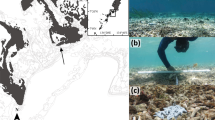Abstract
Nereid polychaetes (Nereis vexillosa and Platynereis bicanaliculata) attach pieces of drift algae to their tube surfaces. The presence of permanent algal cover increases the predictability of the food supply for at least the herbivores (including the nereids) and the deposit feeders, and modulates the temperature and salinity stresses of the marine intertidal soft-bottom environment. However, it may affect the access of organisms to the oxygenated water layers above the sediment surface. This is true for polychaetes that live head downwards in vertical tubes. It is suggested that the attachment behavior of the nereid polychaetes increases the ability of the plant to colonize habitats both temporally and spatially.
Similar content being viewed by others
Literature cited
Brafield, A.E.: The oxygen content of interstitial water in sandy shores. J. Anim. Ecol. 33, 97–116 (1964)
Bruce, J.R.: Physical factors on the sandy beach. Part I. Tidal, climatic, and edaphic. J. mar. biol. Ass. U.K. 15, 535–552 (1928)
Daly, J.M.: Behavioural and secretory activity during tube construction by Platynereis dumerilii Aud. and M. Edw. (Polychaeta: Nereidae). J. mar. biol. Ass. U.K. 53, 521–529 (1973)
Penchel, T.M.: Studies on the decomposition of organic detritus derived from the turtle grass Thalassia testudinum. Limnol. Oceanogr. 15, 14–20 (1970)
— and R.J. Riedl: The sulfide system: a new biotic community underneath the oxidized layer of marine sand bottoms. Mar. Biol. 7, 255–268 (1970)
Janzen, D.H.: Coevolution of mutualism between ants and acacias in Central America. Evolution, Lancaster, Pa. 20, 249–275 (1966)
— Interaction of the bull's-horn acacia (Acacia cornigera L.) with an ant inhabitant (Pseudomyrmex ferruginea F. Smith) in eastern Mexico. Kans. Univ. Sci. Bull. 47, 315–558 (1967)
Johnson, R.G.: Temperature variation in the infaunal environment of a sand flat. Limnol. Oceanogr. 10, 114–120 (1965)
— Salinity of interstitial water in a sandy beach. Limnol. Oceanogr. 12, 1–7 (1967)
Khailov, K.M. and Z.P. Burlakova: Release of dissolved organic matter by marine sea weeds and distribution of their total organic production to inshore communities. Limnol. Oceanogr. 14, 521–527 (1969)
Martin, M.M.: The biochemical basis of the fungus-attine ant symbiosis. Science, N.Y. 169, 16–20 (1970)
Nienhuis, P.H.: The benthic algal communities of flats and salt marshes in the Guvelinger, a sea-arm in the southwestern Netherlands. Neth. J. Sea Res. 5, 20–49 (1970)
Pearse, V.B. and L. Muscatine: Role of symbiotic algae (zooxanthellae) in coral calcification. Biol. Bull. mar. biol. Lab., Woods Hole 141, 350–363 (1971)
Pettibone, M.H.: Marine polychaete worms of the New England region. Part I. Bull. U.S. natn. Mus. 227, 1–356 (1963)
Reid, D.M.: Salinity interchange between salt water in sand and overflowing fresh water at low tide II. J. mar. biol. Ass. U.K. 18, 299–306 (1932)
Roe, P.: Life history and predator-prey interactions of a nemertean Paranemertis peregrina Coe, 129 pp. Ph.D. Thesis, University of Washington, Seattle, Washington 1971
Sanders, H.L., P.C. Mangelsdorf, Jr. and G.R. Hampson: Salinity and faunal distribution in the Pocasset River, Massachusetts. Limnol. Oceanogr. 10 (Suppl), R 216-R 229 (1965)
Stimson, J.: Territorial behavior of the owl limpet, Lottia gigantea. Ecology 51, 113–118 (1970)
Vine, P.J.: Effects of algal grazing and aggressive behaviour of the fishes Pomacentius lividus and Acanthurus sohal on coral-reef ecology. Mar. Biol. 24, 131–136 (1974)
Weber, N.A.: Gardening ants, the attines, 146 pp. Philadelphia: American Philosophical Society 1972
Woodin, S.A.: Polychaete abundance patterns in a marine soft-sediment environment: the importance of biological interactions. Ecol. Monogr. 44, 171–187 (1974)
Zaneveld, J.S.: Factors controlling the delimitation of littoral benthic marine algal zonation. Am. Zool. 9, 367–391 (1969)
Author information
Authors and Affiliations
Additional information
Communicated by M.R. Tripp, Newark
Rights and permissions
About this article
Cite this article
Woodin, S.A. Algal “gardening” behavior by nereid polychaetes: Effects on soft-bottom community structure. Mar. Biol. 44, 39–42 (1977). https://doi.org/10.1007/BF00386902
Accepted:
Issue Date:
DOI: https://doi.org/10.1007/BF00386902




